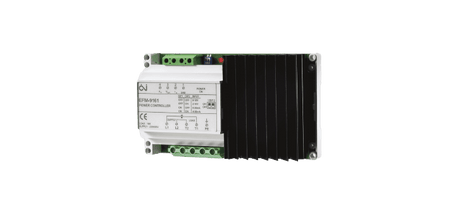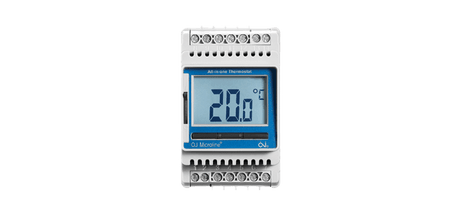HVAC systems - for a good climate in every room

Intelligent HVAC components for heating, ventilation and air conditioning are available from us in highest quality and sophisticated design. By installing an HVAC system equipped with sensors, thermostats, temperature controls and much more, you can improve indoor climate conditions on the one hand and save considerable energy costs on the other. It's good to have a professional partner like us at your side. We are happy to tailor solutions to your individual needs.
Together with our partner OJ Electronics, we have decades of expertise in heating, ventilation and air conditioning
For over 30 years, SEIKOM Electronic has been synonymous with innovative measurement and control technologywhich is aimed primarily at demanding areas. Whether HVAC systems, flow measurement, temperature measurements with temperature sensorspressure measurements with pressure transmitters and much more; we set high standards for our products. As a partner to industry, we also offer an extensive product range with Safety Integrity Level- and explosion protection (ATEX & IECEx)-certified products that meet all requirements for protecting particularly critical and high-risk environments. In addition to the product safety of HVAC systems, you can rely on our customer-oriented service, which focuses on individual advice and speed in all processes relating to your order. We are also your first point of contact when it comes to customized HVAC systems .
What makes heating, ventilation and air conditioning technology so important?
HVAC systems form the central control unit for regulating the temperature, humidity and air quality in certain environments, ranging from offices and workshops to industrial production halls. Heating, ventilation and air conditioning technology contributes to comfort through precise and automated regulation and ensures efficient control of the indoor climate. The aim is to create a pleasant working environment at all times, in which employees can work productively, with concentration and in a health-friendly manner.
In an HVAC system, heating systems provide heat, while air conditioning systems cool environments with high levels of heat. Ventilation systems, on the other hand, effectively control the exchange of stale and fresh air, ensuring high air quality and reducing pollutants and humidity. Modern HVAC systems in particular are designed for particularly high energy efficiency so that you can sustainably minimize energy consumption and reduce your environmental impact.
A major advantage of heating, ventilation and air conditioning systems from OJ Electronics in a closed system is that they can be integrated into almost any building structure thanks to the different shapes and sizes customized - and without much effort. HVAC systems are made up of boilers, air conditioning, moisture extraction and other components, all of which can be found in our range.
How does heating, ventilation and air conditioning technology work?
HVAC systems work through an interplay of heat exchange, air circulation and humidity control to create a comfortable indoor climate. Heating raises the temperature indoors when needed, typically through a boiler that heats water and sends it through a network of pipes and radiators, or through forced air heating that blows warm air through a system of ducts.
Air conditioning systems extract heat and moisture from the interior, whereby a refrigerant absorbs heat and dissipates it via a compressor and a condenser. The result is a cooling of the room air, which is not only important in the summer months, but also essential in areas with heat sources. Ventilation systems are responsible for exchanging stale indoor air for fresh outdoor air. They are usually equipped with an additional filter to clean the air of particles and pollutants.
Modern HVAC systems often come with an automated HVAC control system , which makes it possible to precisely regulate temperature and humidity while optimizing energy consumption through the use of energy-saving technologies such as heat recovery. The effort required is reduced to a minimum, while comfort is increased.

Where are heating, ventilation and air conditioning systems used?
HVAC systems are used in many buildings today, which is undoubtedly related to providing employees with a comfortable workplace , but also simply to reduce energy costs in times ofrising energy prices . HVAC systems also meet today's desire to create a hygienic air quality in which the risk of infection by viruses and bacteria is reduced.
The typical locations of HVAC systems include, among others:
- Office buildings, shopping centers and other commercially used properties
- Production facilities, industrial buildings and warehouses
- Hospitals and clinics
- Schools, universities, libraries and other public buildings
Which HVAC controls we have available for you
If you opt for an HVAC system from OJ Electronics, you will receive sophisticated HVAC components from us that ensure smooth and reliable operation of the HVAC control system. These include drives for fans, drives for rotary heat exchangers, HVAC controls, power controllers, temperature controllers, sensors and transmitters.
Drives for fans
In HVAC systems, fans are responsible for air circulation. Their drives are efficient and reliable to move the airflow through ducts, rooms and over the heat exchanger. The speed of the fans is determined by the drives, allowing fine tuning of the amount of air flowing through the system.
Drives for rotary heat exchangers
Rotary heat exchangers are integrated into HVAC systems to transfer heat from the extract air to the supply air without the two air flows coming into direct contact with each other. The heat exchanger drives are responsible for the rotary movement of the heat exchanger core, which ensures continuous heat transfer and therefore more efficient temperature control.
AHU controls
At the heart of HVAC systems are HVAC controls (room air technology), which are responsible for monitoring and controlling all components. They coordinate the functions of heating, ventilation and air conditioning systems in order to balance a constant room temperature and air quality. HVAC controls are often connected to intelligent building management systems, which enable central monitoring and operation.
Power regulator
The energy supply to the various components such as radiators, cooling elements and fans is controlled by the power controllers in HVAC systems. They regulate the output based on the requirements of the system and help to minimize energy consumption by avoiding over- and undersupply.
Temperature controller
Temperature controllers in HVAC systems keep the desired room temperature constant. They react to changes in the indoor and outdoor temperature and adjust the operating mode of heating or cooling elements accordingly. This not only ensures comfort, but also efficient energy utilization.
Sensors and transmitters
Sensors in HVAC systems continuously collect data on temperature, humidity, air quality and other important parameters. Transmitters send this information to the control systems, which then adjust the HVAC components accordingly.
With our selection, we ensure that you can exploit the full potential of an HVAC system. In our product categories exactly what you need in our product categories. We will be happy to advise you personally on tailor-made HVAC systems and components at any time and provide you with an attractive offer. We look forward to hearing from you without obligation.






